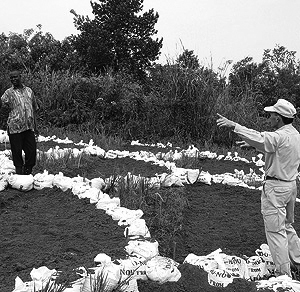Japan's Official Development Assistance White Paper 2009
(4) Agriculture
In developing countries, three out of four poor people live in rural areas, and most of them make a living on agriculture. The MDGs set the reduction of poverty and eradication of hunger as its main objectives. Agricultural and rural development is essential in reducing poverty through sustainable economic growth.
<Japan's Efforts>
Japan emphasizes cooperation in the agricultural sector for reducing poverty, and actively works to address food problems as a global issue. Japan promotes food assistance for developing countries which are faced with food shortages over the short-term, as well as efforts to support ownership of developing countries for the development of sustainable agriculture in the medium to long-term.
Specifically, Japan uses its experience and expertise in providing support for rice cultivation techniques and for the organization of farmers, while also developing infrastructure such as irrigation facilities. Moreover, it also supports the dissemination of production techniques and research and development, such as New Rice for Africa (NERICA) in Africa. In addition, it also provides support through international organizations (Food and Agriculture Organization (FAO), International Fund for Agricultural Development (IFAD), Consultative Group on International Agricultural Research (CGIAR), World Food Programme (WFP), etc.).
Furthermore, the Coalition for African Rice Development (CARD) was announced at a side event to TICAD IV, which was held in 2008. CARD is a consultative group wherein donor countries, African regional organizations, international organizations, and others participate in partnership with rice producing countries in Africa that are interested in promoting rice cultivation. It aims to double the volume of rice produced in Sub-Saharan Africa from the current 14 million tons to 28 million tons in ten years.
Moreover, at the expanded meeting on food security at the G8 L'Aquila Summit in July 2009, Japan announced that it was prepared to provide assistance of at least US$3 billion or so over three years from 2010 to 2012 in agriculture-related sectors, including infrastructure.
The Project for Construction of Rice Research and Training Center (Uganda)
Developing agriculture is a priority issue for assistance to Uganda, and so Japan has supported the development of NERICA, a new type of rice for Africa, through technical cooperation. However, about 60 years have passed since the construction of the National Crops Resources Research Institute in Uganda, which serves as the research and training center for this, and its facilities and equipment are deteriorating. As such, Japan has donated facilities like practice facilities, training buildings, irrigation facilities for training, and dormitories, as well as equipment like agricultural machinery, equipment for repairing agricultural machinery, and tractors for training to the research institute free of charge. This support aims to improve the quality of rice cultivation research and training, and the expectation is that this will facilitate the fostering of human resources related to rice cultivation and the promotion of rice cultivation in Uganda, and will also contribute to improving rice productivity.

Photo: JICA
Punjab Irrigation System Improvement Project (Pakistan)
Improving agricultural productivity has come to be a challenging issue in Punjab Province, which produces about 80% of the wheat and cotton produced in Pakistan as a whole. As such, through an ODA loan of about ¥11.4 billion Japan supports the repair of irrigation facilities and water resource management facilities in this region, as well as the improvement of irrigation services and the establishment and fostering of farmer organizations. It aims to increase the efficiency of water use, improve agricultural productivity, and raise the income of small-scale farmers, many of whom are poor, through such support.
